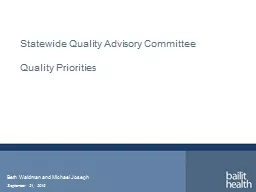PPT-Statewide Quality
Author : olivia-moreira | Published Date : 2016-09-08
Advisory Committee Quality Priorities September 21 2015 Beth Waldman and Michael Joseph Agenda Welcome and Business Items 300 305 MHAMAHP Proposed Tiering Measures
Presentation Embed Code
Download Presentation
Download Presentation The PPT/PDF document "Statewide Quality" is the property of its rightful owner. Permission is granted to download and print the materials on this website for personal, non-commercial use only, and to display it on your personal computer provided you do not modify the materials and that you retain all copyright notices contained in the materials. By downloading content from our website, you accept the terms of this agreement.
Statewide Quality: Transcript
Download Rules Of Document
"Statewide Quality"The content belongs to its owner. You may download and print it for personal use, without modification, and keep all copyright notices. By downloading, you agree to these terms.
Related Documents














